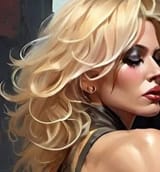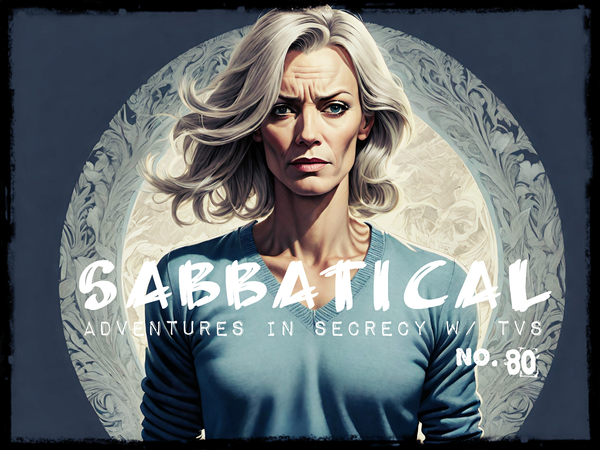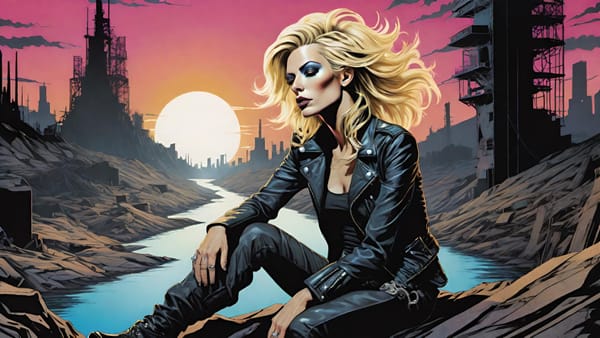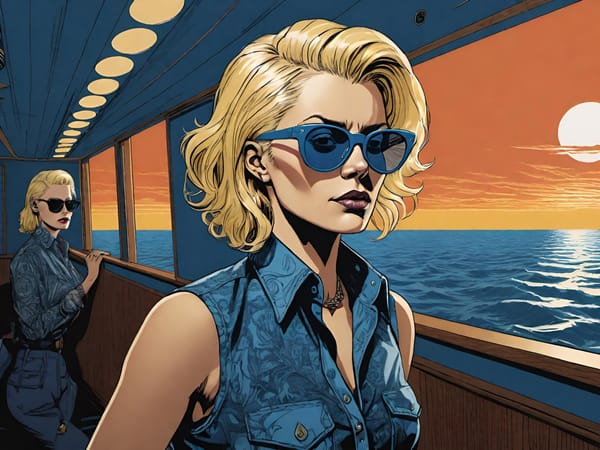What’s the Secret of Secrets?
So. I wrote a little booklet thingy years ago to try and introduce new readers to the Secretsverse. It is in need of revision, and since Tablo has more or less abandoned its author profile UX after destroying it, imma do it here, instead.
Frankly this could be its own section of Adventures in Secrecy, and may very well come to be so. But, let me at least attempt to be concise and compact, and give you as much of a boost up in one go as I can.
Here we go …
Secretum Secretorum
The Secret of Secrets is my series of New Wave-y sci-fi books beginning with Everything Fails. It is, in a sense, one very long book—what I sometimes onerously refer to as a ‘meganovel.’ But it’s a lot more than that because each book is a complete novel in its own right, with its own themes and ambitions. Plus, the series is metafictional, so the books themselves are discussed in the books themselves, if that makes any sense. There are also some completely fictional books within the series: The Book of Life, The Book of the Dead, The Secret of Secrets (which is a comic book), The Black Book of Fear (not to be confused with the real book, T Van Santana & The Black Book of Fear), and some novels by my bioidentical duplicate, Teresa Anderson, including: Conversations with an Antimuse, Notes from the Brubaker, and Under the Brim. There’s also the first book I wrote in the first book—I know, I know—called I Am Made to Remember! which I have also titled Scenes from the Tank at times.
But, if you’re only interested in the real books themselves—which, you know, would be understandable—you can find a complete set of links for them here.
Who’s Who in the Secretsverse?
A noble question, my dear bae. There are many characters—too many for your taste, quite likley—but a few tend to recur and maintain narrative significance, even when absent. They are …
Me, myself, I—that is Teresa Van Santana, your humble narrator. I split my time between the 21st and 32nd Centuries, working in the future as a private secretist; and, in what you call the present as, well, a writer. I do other things, too, but they’re secret, so sorry but I can’t tell you. My legal name in the 32C is Willa Teresa Anderson; T Van Santana is my penname, as it is in your time, as well. I have a bioidentical narrative duplicate (a ‘clone’ if that’s easier to hold onto) also named Teresa Anderson. It can seem confusing at first as to which Teresa is talking, but you’ll get used to it, promise.
Lila Juno. She’s my wife and the mother of our two children, Mason and Fox. Lila’s a filmmaker by trade, which is one of those dead but revitalized artisan niche occupations in the Thirty-Second Century. You know the kind. We used to get on famously; but, as of late, we do not get along very well. This had led to me becoming trapped first within my own body—The Lost City of Soma—then in the Library Eternal. It’s a drag. It all works out; I’m sure of it. And it leads us to a much better place, which will be detailed in a book called The Lilac June. But since it hasn’t happened yet and I am still stuck, I don’t know how. We will discover it together!
My oldest Mason is 11 but is about the size of a 14 year old. They are curious and talkative and loves stories and cats, just like their parents. They came to understand themselves as nonbinary at age six and use singular ‘they’ pronouns, like me.
My son Fox is 6 and is also big for his age. He’s a born performer and one of the most delightful people I’ve ever known. He hasn’t been featured as much in the books yet because I’ve been stuck in this damn Library. But you will see him mentioned starting in the tenth one and thereafter.
Horace Délasser is my best friend since childhood—my brother, really. He’s married first to Ada, then later to Dole. He and Ada have two kids that I call Crow and Weasel. Horace is a major in The Ministry of Planets Armed Response, Aerospace Division. He’s also a spy. But you don’t know that, right? Could be hazardous to your health.
My Friend on the Inside. So, hey, I’m sorry but some of the characters in my books don’t really have names at first. I know, I know. This requires a little more effort on your part—as the reader, I mean—because you have to sit there and wonder who the hell this person is with only a description like “my friend on the inside.” So who is it? Well, they are Brim, like I was. They also give me clues to their identity as the series goes along. If you really want to know who they are, that gets revealed in book 6, Love Is What You Have. They give me a codename for them in book 5, We Can Never Go Back, and that’s when I start trying to guess who they might be. But, yeah, that’s books 1, 2, 3 & 4 of not knowing who they are at all. Which is rough, I’ll grant you that. But, hey! It’ll make the pay off interesting, right?
Klava. Oh, jeez. Let’s see. How to describe Klava. Well, she’s an assassin. She’s from another place, like another reality altogether. I access this reality through a series of sites where the boundary between the two worlds is weak. You’ve heard of stuff like before, right? Of course you have. Anyhoo, Klava’s very reliable and we have kind of a thing, but she’s also very violent—you know, like you might expect an assassin to be—and usually takes odd forms of payment. Like body parts. She’s introduced in book 2, These Are The Things I Know, and is in most books thereafter, but plays an especially prominent role in book 4, The Thieves of All That You Are, and book 6, Love Is What You Have.
Cobie. That’s my nickname for Maria Luisa Jacobi. She’s my personal physician, a role she never really signed up for but sort of fell into. She’s an ophthalmologist, but I kind of go to her for whatever I need medically. Oh and we used to date. So there’s that. I don’t ever say it explicitly in the books, but she’s also a little Aspie.
Condé Groesbeek. The mysterious galactic restaurateur who buys the shitty coffee shop next to my place of work and turns it into a decent café. We become friends but … it’s complicated. Our relationship is detailed in book 3, The Grand Story of Not, book 4, The Thieves Of All That You Are, and book 5, We Can Never Go Back.
Knot. Well, let’s see. Knot is not from my present but my future. They know a lot about me and my life. They can read not only body language as I can but actual thoughts. They are the Master Secretist who teaches me the secret of secrets. They claim to have been with me throughout various difficult points in my life—such as the Blast, Down In The Underground and stuff like that—but I really have no idea who they are. Yeah, yeah. They showed me their face once, so I actually know now, okay? But I’m not telling. I think there’s a lot of clues, though, so you can piece it together if you want. They first appear in book 3, The Grand Story of Not.
Dwizaal. I usually just call him D. His nature and identity is one of the central mysteries of the series, so I don’t want to say too much about him. I’ll lay it out as clearly and non-spoiler-y as I can. Whatever he is, he’s tied to the Jungle Planet where I grew up—that’d be Meezed-Zedbee II. Some people on the Jung can see him other than me, but no one on other planets seem to be able to see him. (Well, other than Knot.) Most of the myth surrounding him on the Jung is that he’s a demon. Like, the possessing sort of demon. But at other times he’s said to me that he’s something more like a displaced soul. And he’s got a grudge against me. Why? Well, that’s part of the mystery, y’all.
What’s the word on the street?: A 21st-32C Lexicon
So look: no dictionary is perfect, m’kay? I’m doing my best here to transliterate two very different time periods into an understandable form for the 21st—which is a tough crowd, by the way.
This list is also very effing far from complete. I’ll do my best to update it.
Babyrocket
A stroller-carrier system for babies that has automated components to it. Parents in the 32C love them. They’re dangerous, IMHO, but I use them from time to time because busy.
Beam
A beam is probably most analogous to a tv show or a newspaper. It’s a serially updated piece of media. People can watch beams on personal external readers or through implants.
Bit
Bits are the basic unit of galactic currency.
E.g., “I just bought this rad 500 bit dress,” or “Ten thousand bits? You gotta be fuckin’ kidding me! No way it’s worth that much.”
One carries bits in a bitpurse, which sounds a lot like “coin purse” used to; however, bitpurses are not literal purses but tiny chips. Bits are transferred touchlessly through secure broadcast, bitpurse to bitpurse, Most bitpurses are embedded in other objects—like a bracelet or something—though you can transfer the little chip dealie to clothing or pretty much anything. Some people have them installed in teeth. Ew.
Brims & Trenches
I started my professional career as a secretist working for the galactic government. The name of the agency I worked for is the Ministry of Secret Matters, sometimes just called the Ministry of Secrets. My nickname for people who work for the Ministry of Secrets is Brims & Trenches. Why? Because they wear a fedora-style hat and a long coat, like a trench coat. They also wear identity masks, which are literal masks, yeah, painted pale with black lips, but they also mask the wearer’s bioelectromagnetic signature. (Note that I said, “mask” not “hide;” see ghosting for more info on hiding that shit.) The astute reader will notice that I use they/them pronouns for Brims (yes, even in the singular) because their gender is usually concealed. “Brim” is also considered insulting by some—kind of like “cop” in the 21C.
Bubble™, Brought to you by CoDex Corporation and Cosmic Communication Concern
People get confused about Bubble, but I’m not sure why. It’s just social media, okay? It’s the 32C version of all that. Wanna talk to someone? Blow them a Bubble. Don’t get them? Let a message stick to their paper. See? Easy peasy. Now, if you want to actually talk to someone in real life, good luck with that …
Bull
A somewhat racist term for a Tauran. I’m not personally offended by it, but it’s not a good look to go around dropping words like this. Oh, and many secretists are Taurans—though certainly not all—so sometimes people use the word “bull” to refer to a secretist also, even though that’s not always correct. Language, right? People talk how they talk!
Cars
Yeah, we got ‘em. Ours fly, which is rad, and most are interstellar capable. They also have standard autopilot and virtual assistant personalities. Cars don’t “park” in the 32C, they “dock.”
Chems
Short for chemicals, okay? This covers illicit drugs as well as legal ones. I don’t do a lot of drugs these days, but I used to in the Jung. I occasionally use legal, performance enhancing chems for difficult field work.
Dock
Both the physical space where cars are stationed and the act of stationing a car to rest so you can disembark. So it’s not a parking lot, it’s a parking dock, or just a dock. Lots of ‘em are on rooftops.
Enby
A person with a nonbinary sense of gender. Usually it’s an identity thing, but it could cover expression too. This is the safest assumption to make if you don’t know someone. But remember what they say about assumptions …
Ghosting
Every living thing gives off energy signatures. A lot of non-living things, too. Anyhow, ghosting is a set of techniques for hiding one’s energy signatures so well that you appear to not be there. Notice this is not the same as masking because that will show either an absence of energy where there should be some or a distortion of what one would expect to see. No, ghosting is close to true invisibility because you’re matching the surrounding energy. I’m Tauran, so this comes easier to us than humans.
Gravity door
A special, rotating door that manages different gravity levels in environments where gravity is variable.
The Jungle
Technically it’s Meezed-Zedbee II, but most people call it the Green Jungle Planet. I almost always refer to it as the Jungle or the Jung. I moved there at the end of 3076, when I was about 11½. Book 7, Be A Dark Horse! (alternately titled A Ministry of Ignorance) is all about the Jung. I sometimes use ‘jungle’ as an adjective to describe any old lunacy that I think is reminiscent of the sort of wild shit one might see in the Jungle. Notice that I am just as like to say “in the Jungle” as “on the Jungle.”
Kinny
A kinesic register. Okay, thanks, T. What the eff is that? A kinesic register spots body movements, gestures, and other nonverbals and compares them against a database to give the user a probable intention of the actor. It’s used by security to spot dangerous people, by healing professions to understand how people are feeling—especially when they don’t themselves understand what they’re feeling, and by secretists to … well, that’s secret. I have one installed in my brain—a kinny, I mean. I think in some early drafts it’s referred to as ‘kin-reg’ and ‘reggie’ as well. It’s all the same thing.
Mim
Mim, mimsy, and Jesse James are all the same thing. It’s illegal, street-grade mnemosynoxone, which is a memory altering chem used a lot in interrogation. Mim’s super popular because it lets the user revise history to how they’d prefer to remember their life rather than how it actually happened. The effects aren’t lasting, though, so you gotta take more. Ends up creating a dementia-like effect in long-term users but does not respond to dementia treatment. So it’s bad effing news.
SEAR
A mysterious disease that stands for, I think, Sporadic Encephalitis with Acute Remissions. Disease in the 32C is complicated because we don't usually get sick. We've eradicated most harmful microbes and trained the rest to be symbiotic. Scientists also long ago edited our RNA to make us able to learn how to cooperate with microorganisms efficiently, so no one really knows why some folks still get sick. It’s a thing I may explore in later books and stories, but haven't really gotten to yet.
Secretist
Here’s what I can tell you: it’s a professional job that requires a minimum of a few years of preparation and training, the job duties of which include meeting with people in secret, listening to what they have to tell you, and then not telling anyone else what’s been told to you. There’s more to it than that—like, a lot more—but that’s all I can tell you. Why? ‘Cause it’s secret. Duh.
Shielded circulation
Physical reinforcement of arteries and veins to protect against rupture. Many Brims have this enhancement.
Swiggle
A competing but somewhat interlacing telecommunication product that’s similar to Bubble™. Its focus is more on using still imagery, preproduced vids, and pithy text to grow ones brand strength rather than actual communication. But who’s keeping track, really? If you ain on Swiggle making a Swiggle spew and getting people to watch your swagger, than you’re irrelevant in the 32C. Or so my publicist keeps telling me.
Tauran
Folks from an alien minority supposedly originating in a planetary system around Aldebaran (also known as Alpha Tauri)—but who the hell knows. There aren’t too many of us, and we’re not super good at sticking together. Our differences are mostly genotypic, so we look and act like other humans. Well, more look than act, in my humble opinion, but whatevs. We’re better at certain things—or at least have that reputation—such as feeling the feelings of others, sensing danger, and hiding.
They/them
I use ‘they’ and ‘them’ to refer to people when either a) I do not know their gender, or b) that is their preferred set of pronouns. It’s my preferred set, by the by, even for the singular. This is in no way grammatically incorrect for two reasons: 1) way better writers than anyone who would offer criticism of this usage used they in this manner, writers such as, oh, I dunno, Chaucer and Shakespeare, and 2) there are people who use the words in this way in real life, as opposed to some ivory fucking tower somewhere handing down edicts on how people should speak versus how they actually do. If it seems like I have some anger on this subject, you’re not wrong. This is a 21st Century thing, by the way—not a 32C thing. So wake up and join life, please.
The 32C
The 32nd Century, part of the 4th Millennium—which I sometimes call the 4Mill or the Fourth Milly—we’re about 90-ish years shy of the 13.0.0.0.0 long count, if you’re into that sort of thing. Life’s not so different from the 21st—at least, that’s what I think, and part of why I’ve chosen to compare the two times. It’s also a metaphor for the disappointment of the actual future as now present when contrasted with the expected future of the past. If that makes any sense. If not, just ignore it.
The 21st
The century of human history in which you find yourself. I am totally fucking enamored of it, which is why all my novels are written in a 21st Century style. Some would say that’s also why they are difficult to read. But you can’t listen to critics, or you won’t write a fuckin’ thing.
When’s all this happening?
Okay, so it’s fair if you feel confused about when things are happening. The story involves memory, bending time, and alternate dimensions—and, of course, distortions of all these by characters either accidentally or on purpose. So that’s a lot to handle. I get it.
I’ll give you some simple guide posts, okay? Hopefully that’ll help.
3102. That’s the “start” of the series, meaning it’s the “present” of the first book, Everything Fails. Now, that book deals a lot with memory—like, a lot—so there’s some jumping around. But it’s mostly between the “present” of 3102 and the “past,” which was my secondary school years, so that’s something like 3076-3082. Some memories happen a bit after that—like in the 3088 range—but the main thing to remember is that most of the toggling in the first book is between 3102 and, like, 3080-ish. Or, to put it another way, between my early middle age years and my adolescence, making it a kind of memoir cum Bildungsroman and a bit of a psychological novel, as well.
The “present” of the books moves fairly slowly. I mean, by book 8, The Stars Call Us Home, it’s only 3104. That’s 8 books covering about two years. Time starts to jump around a lot more around book 15, No One Ever Knows Why, but don’t worry about that. By then, you’ll be very familiar with the program.
There are some events in my life that have their own name. I’ll give them to you here, along with when it happened and how old I was, approximately. I won’t tell you what each is, though, cos spoilers.
The Blast happened on the Jungle Planet in the summer of 3081. I was about 16.
The Hot Second also happened on the Jungle in ’81 but in the fall.
I was Down In the Underground in 3088 on the Ministry Homeworld from about age 23 to age 26.
Where the eff are we?
Again, fair question, babe. Lemme break it down for you.
Okay, so I was born and currently live on the Galactic Homeworld of Aemericce Prime. I usually just call it the Homeworld or the Homedub (dub, here, being short for the letter w, which starts the word world.) My sister, Angie, calls it the Homesquirr, but that’s unique to her, and I just borrow it from time to time. It’s most often referred to as the Ministry Homeworld because the Aemerice government thinks it owns everything in the galaxy. It doesn’t, which is the cause of a lot of problems I have yet to explore directly in the books. But I allude to them, if you’re paying attention. If you’re not, never you mind.
The majority of the “present day” action of the books takes place on the Homeworld.
I live with my family in the City of Rivers, which is the Homeworld Capital. Horace and his family live there, too.
Most of my extended family is in Blackwater—which is the small town on the Homeworld where the CoDex Corporation began.
The second most common place of action is the Jungle Planet, Meezed-Zedbee II. I often just call it the Jungle, but sometimes the Jung, da Jung, the Big Nasty. I lived there for the entirety of my adolescence and part of early adulthood, and its effects have been … lasting. In the first six books, the Jungle is mostly seen in the past, but book 7, Be A Dark Horse!, is set entirely on the Jung—past, present, and future.
Then there’s all these other planets, like the Golden Planet, the Diamond Planet, the Tidal Planet, the Twin Planets, and so on and so. But they’re not all that important. I mean, I grew up on the Gold when I was in elementary school, but I have yet to really get into that much. Most of what you need to know about these places you can pick up from context. I hope. If not, maybe you’ll learn how?
So those are the main basic mundane locales. Ready for the far out stuff? Then here we go …
The Dream World
It’s just like it reads on the tin. The world (or worlds) where you go when you close your eyes and fall asleep. I’m an expert lucid dreamer, so that world is just as real to me as the waking world of the 32C. The rules are hella different, though. So, like, time doesn’t really apply the way it does in waking life, nor does relativity or constancy or any other laws of the natural world. But why am I explaining this? You’ve dreamt before, right? This world shows up sporadically and is first explored in detail in book 2, These Are The Things I Know.
The Other World
An alternate dimension that’s more like your world than the Dream World but has some elements of both. My occasional companion, Klava, is from there. Folks from the Other do not like leaving the Homeworld but can. Haven’t really figured out why that is yet.
The Alternate Timeline
At the end of book 4, The Thieves of All That You Are, I ink a deal with the CoDex Corporation for a reality show based on my life—hope that’s not too spoiler-y. In most of book 5, We Can Never Go Back, I’m working on that show. So one of the ‘timelines’ of the series is the timeline of the beam show based on my life—which is also, confusingly called “The Secret of Secrets.” I begged them to call it something else, but hey ... I’m just the writer. Why would they listen to me?
The Lost City of Soma
The City of Soma exists within me. Like literally within my cells. Book 13—which is called SOMA—is set there, as is book 14 and Teresa’s Backbone. Book 15, No One Ever Knows Why, begins with a very old version of me leaving the city. But let’s not get too far ahead, m’kay?
The Library Eternal
So I get trapped within the Library Eternal while in Soma, but we first see it in book 2, These Are the Things I Know. (I think it’s that one … pretty sure.) Some readers have opined that it is home to the Akashic records and, well … I’ll let you decide. It definitely has some commonalities with Borges’ “The Library of Babel.” Though that wasn’t really intentional (insofar as I can recall), I am honored to be in his company.
Why this series?
Origin
I didn’t know the name of the series until I was writing book 3, The Grand Story of Not. I didn’t even know I had a series until the idea for the third book came.
I started with Everything Fails, which I subtitled as “a science fictional memoir.” That was gonna be it. A few months later, an idea for a companion piece came—that’d be book 2, These Are The Things I Know. I wanted to subvert reader expectations, though, and do something totally different. So while I kept the world and myself as the main character—who didn’t have a name or description, by the way—I wanted to write a book about magick and gnosis without any explanation, really, for the genre shift. That went swimmingly—at least I think so—and then in no time, I got an idea for a third.
Well, I’m not a fan of the trilogy—and no offense intended to anyone who is … it’s a fine thing, but for me it seems like everything’s expected to be a trilogy … with the last book split into two movies, but never mind that—so that meant there’d have to be at least one more. And so book 4, The Thieves Of All That You Are, came to be.
Books 3 & 4 are more consistent in tone with one another, and with both of them, I went back to book 1 for inspiration and to see which characters and plot hooks’re still hangin’ out and just kind of built from there.
Aspirations
I want to subvert a lot of genre conventions and tropes but still have some respect for them. I want to tell deeply personal stories in an accessible way that hopefully reaches people. Some of the feedback I’ve gotten is that I say well what others feel and have trouble articulating. That’s pleasing feedback and something I hope to continue in this series.
I want to be brutally honest about my shortcomings and insecurities. In doing so, I hope I can normalize a lot of doubts people have about who they are and how they feel about the people they care about, open up some walks of life that are considered ‘alternative’ at this point (but hopefully will be part of ‘normal’ real soon), and just generally provide some reassurance that it’s more than okay to be yourself—that it’s really the best any of us can do.
I want to be inclusive and sensitive to people from all walks of life. That’s a tough one, especially when you’re trying to show flawed characters who don’t do nice things. I think people can tell, though, even with a first person book, when something’s a character choice or an author choice. It’s hard to point out how, but I think it comes through. Hope so, anyway.
Writing as a therapeutic document
A lot of what I write about is tied to problems I have in my everyday life. Writing about them is my way of trying to work those things out. Does that mean I’m running around stabbing people? Of course not. It’s metaphor. But everything in these books is rooted in emotional honesty and a lot of it is born from the earnest struggle to understand myself better and change how I show up in the world.





